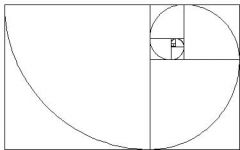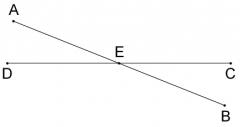![]()
![]()
![]()
Use LEFT and RIGHT arrow keys to navigate between flashcards;
Use UP and DOWN arrow keys to flip the card;
H to show hint;
A reads text to speech;
27 Cards in this Set
- Front
- Back
|
Euclid's Elements is considered a great work because
|
It introduces a new concept/idea, is influential, applicable, accessible, and stands the test of time.
|
|
|
Common Notion 1
|
things which are equal to the same thing are also equal to one another. AB=AC=BC
|
|
|
Common Notion 2
|
If equals are added to equals, the sums are equal.
|
|
|
Common Notion 3
|
If equals are subtracted from equals, the remainders are equal.
|
|
|
Common Notion 4 |
Thing which coincide with one another are equal to one another.
|
|
|
Common Notion 5
|
The whole is greater than the part.
|
|
|
Postulate 1
|
You can draw a straight line between any two points. "Draw CA and CB." "Draw AB"
|
|
|
Postulate 2
|
You can extend the line indefinitely. "Extend DB to meet the circle, label intersection G."
|
|
|
Postulate 3
|
You can draw a circle using any line segment as the radius & any point as the center. "Make a circle with center A and radius AB."
|
|
|
Postulate 4
|
All right angles are equal.
|
|
|
Postulate 5
|

Given a line and a point, you can draw only one line through the point that is parallel to the first line.
|
|
|
Proposition 4
|
Known as Side-Angle-Side
|
|
|
Proposition 8
|
Known as Side-Side-Side
|
|
|
Proposition 26
|
Known as Angle-Side-Side.
|
|
|
Proposition 47
|
Known as Pythagorean Theorm A squared plus B squared = C squared.
|
|
|
The Elements by Euclid
|
13 books, with 467 propositions, beginning with 23 definitions, 48 propositions, and Ten Axioms split into 5 postulates and 5 common notions
|
|
|
When did Euclid live/write The Elements?
|
300 BC, Alexandria,Egypt. "Father of Geometry" influenced by Plato.
|
|
|
The ratios of consecutive Fibonacci numbers approaches the...
|
Golden ratio. 1/2, 2/1, 3/2, 5/3 get closer to 1.618.
|
|
|
Properties and facts about the golden ratio
|
It equals to infinitely many 1's. 1) Phi=1+1/phi. 2) Phi squared= phi +1. 3)Phi -1 =1/phi=phi-1. 4)Phi=phi/1=1/phi-1. |
|
|
If you remove a square from one end of a golden rectangle, then:
|
the rectangle that is left is also a golden rectangle. Proven by Property #4. Lesson for life: Explore Consequences of New Ideas.
|
|
|
Logarithmic Spiral, Eye of God
|

Where the spiral and two lines cross. interesting fact: same angle, no matter where on spiral you form a tangeant line. |
|
|
Where is the Logarithmic Spiral found in nature?
|
Hurricanes, Galaxies, Elephant tusks, Stars
|
|
|
Why do you find consecutive Fibonacci spirals in so many places in nature?
|
Because ratios of consecutive Fibonacci numbers provide the best approximation for the golden ratio, and plants use golden ratio to optimally pack. (fitting the most amount of stuff in the smallest space)
|
|
|
Proposition 1
|
To construct an equilateral triangle on a given finite straight line. Uses Post. 3, Post. 3, Post. 1, Def. 15, and CN 1. |
|
|
What is the area of a golden rectangle with a short side of 2cm?
|
long side/short side= phi. Lesson for Life: Understand the initial, and seek the essential. long side/2=phi/1. long= 2phicm. Area= longxshort. =2(phi)x2. =4phi cm squared. |
|
|
Proposition 15
|

If two straight lines cut one another, then they make the vertical angles equal to one another. Uses Prop 13, Prop 13, Post 4, CN 1, and CN 3
|
|
|
Who influenced the Elements?
|
Scientists: Galileo, Kepler, Neuton. Philosophers: Descartes, Spinoza. Presidents: Thomas Jefferson, Abraham Lincoln. Other: Albert Einstein.
|

